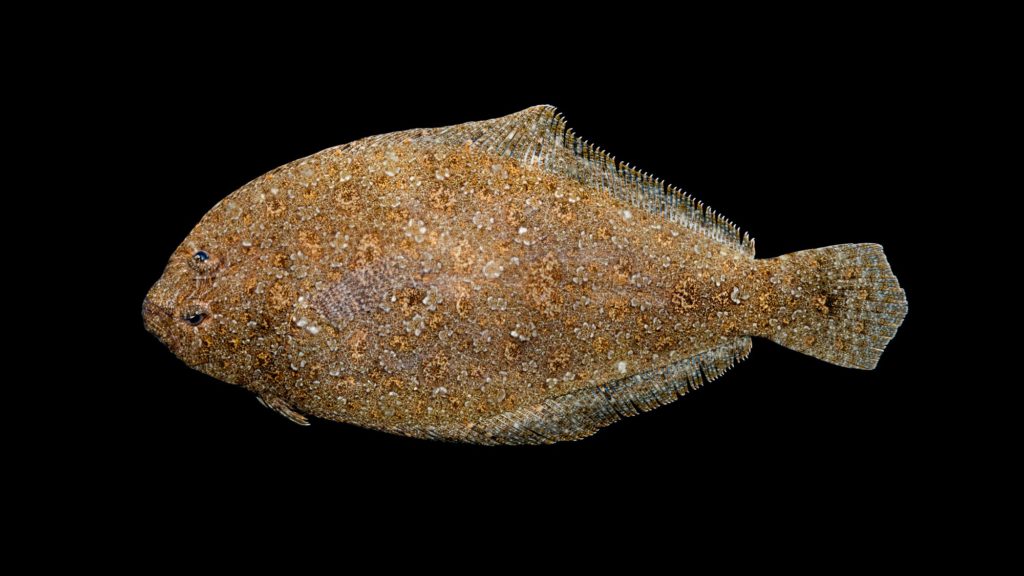| Family | Scientific Name | Author | Year | Common Name |
| Paralichthyidae | Syacium micrurum | Ranzani | 1842 | Channel Flounder |
Syacium micrurum
Unique Characters for Syacium:
No distinct arch in lateral line above pectoral fin on ocular side and lateral line not prolonged below inferior eye. Base of pelvic fin on ocular side on midventral line. Urinary papilla on blind side. Branched caudal-fin rays 11, rarely 10 or 12. Mouth large, maxilla less than 3.5 in head length usually reaching posteriorly to vertical through mideye. Jaws on blind side not arched; front teeth in jaws enlarged, larger than lateral teeth. Both jaws with a single row of fixed (immovable) teeth. Upper jaw with 2 rows of fixed (immovable) teeth.
Unique Characters for Syacium micrurum:
Males – Specimens greater than 120 mm standard length. Interorbital width less than 75% of lower eye diameter. Ocular-side pectoral-fin rays elongate, greater than 25% standard length (males). Interorbital width less than 35% of lower eye diameter in specimens 120-150 mm standard length, less than 50% in specimens 150-180 mm standard length, and never exceeding 75% of lower eye diameter.
Females – Specimens greater than 120 mm standard length. Interorbital width less than 75% of lower eye diameter. Ocular-side pectoral-fin rays not elongate, less than 25% standard length (females). Interorbital width about 20% of lower eye diameter in specimens 120-150 mm standard length, increasing to about 27% in specimens to 195 mm standard length. General body color light tan to brown; mottling on body and fins; several large black blotches on lateral line.
Specimens less than 120 mm standard length. Snout length 80-92% (mean 83%) of shortest distance from tip of snout to orbit of upper eye. Interorbital width generally less than 15% of lower eye diameter.
Similar Species: Dusky Flounder, Syacium papillosum

Unique Characters for Syacium papillosum:
Males – Specimens greater than 120 mm standard length. Interorbital width greater than 75% of lower eye diameter. Anterior rays of pectoral fin on ocular side elongate, exceeding 25% standard length. Pigment lines (bluish in life, brown after preservation) running anteroventrally from upper eye, may also be present on interorbital region, lips, mandible, and urohyal. Blind side dusky.
Males – Specimens greater than 120 mm standard length. Interorbital width less than 75% of lower eye diameter. Ocular-side pectoral-fin rays elongate, greater than 25% standard length (males). Interorbital width usually 30 to 70% of lower eye diameter in specimens 120-150 mm standard length, 50-90% in specimens 150-180 mm standard length, and exceeding 75% of lower eye diameter in larger specimens.
Females – Specimens greater than 120 mm standard length. Interorbital width less than 75% of lower eye diameter. Ocular-side pectoral-fin rays not elongate, less than 25% standard length (females). Interorbital width 25-35% of lower eye diameter in specimens 120-150 mm standard length, increasing to 60% in specimens about 220 mm standard length. General body color dark brown, little or no mottling.
Specimens less than 120 mm standard length. Snout length 54-74% (mean 66%) of shortest distance from tip of snout to orbit of upper eye. Interorbital width generally greater than15% of lower eye diameter.
Gallery